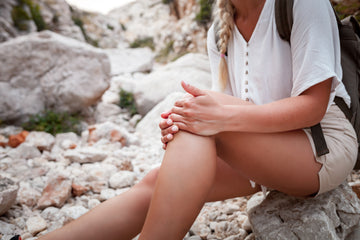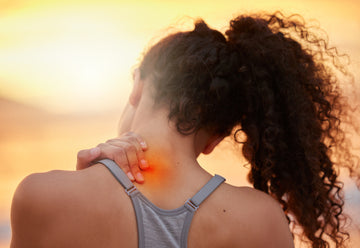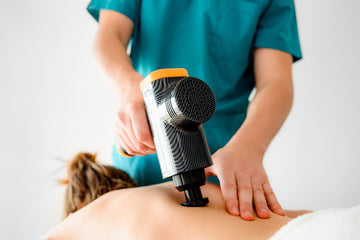Hiking can take its toll on the body, but one of the most common problems people face is knee pain after hiking. Commonly known as "hiker's knee," this condition can affect frequent hikers, but it isn’t limited to only those who hike. Whether you’re an avid hiker or not, learning how to identify and alleviate this condition can help with reducing the pain and strain felt from “hiker’s knee.” In this article, we'll look at hikers knee in detail and suggest some treatments that a you can apply to deal with this problem.
What Exactly is Hiker's Knee?
Hikers knee, medically known as patellofemoral pain syndrome (PFPS), is a prevalent condition among hikers that leads to persistent knee pain from hiking. This discomfort primarily arises due to repetitive stress on the knee joint during prolonged and intense hiking activities. The repetitive motion, such as ascending and descending steep terrains, strains the patella (kneecap) and the surrounding structures, causing inflammation and irritation. Despite its name, this problem can also come from frequent kneeling or squatting activities.
Types of Knee Pain Caused by Hiker’s Knee
The kneecap can display several types of pain, and since this part of the body has many component pieces, pain there may stem from several sources. The discomfort that a person may encounter after hiking includes:
- Anterior Knee Pain: This type shows up as an ache around the kneecap and may be a result of misalignment of the patella.
- Medial Knee Pain: In this situation, the ache comes from underneath the patella and is usually a result of cartilage wear or strained ligaments.
- Lateral Knee Pain: The outer sides of the knee hurt in this condition, usually from the iliotibial band (IT band) friction or lateral meniscus problems.
Understanding the part of the knee that aches can help you determine if the ailment is considered hikers knee or if you need to visit your physician for a more pressing knee injury. If you have knee pain from hiking downhill, you should speak to a doctor as soon as possible and stay off the knee as much as possible. Continual use will strain the ligaments and muscles there and may cause irreparable damage.
Immediate Treatment Options for Knee Pain After Hiking
You may not be able to get to a doctor right away, so immediate treatment options for knee pain from hiking downhill should be your first concern. Among the options you have for at-home care after repetitive motion injuries are the following:
- The RICE Method: RICE stands for Rest, Ice, Compression, and Elevation. While cold therapy helps manage inflammation, heat therapy can also be used, depending on your preference.
- Over-the-Counter Relief: Most pharmacies stock a wide range of elixirs, pills, and rubs that claim to aid knee pain from hiking downhill. Non-steroidal anti-inflammatory drugs (NSAIDs) like ibuprofen or acetaminophen can help to deal with this ache over the short term but does nothing to address the root problem. They should be used cautiously.
- Massage: Massages with heat and cold therapy can help increase blood flow and decrease inflammation around the knee. Massage chairs with these functions can bring the convenience of a massage at home after a long day of hiking.
These are short-term remedies which may deal with the immediate effects of knee pain after hiking, but if the discomfort persists, you should consult a doctor or medical professional.
Longer-Term Treatment Options for Knee Pain From Hiking
Persistent aching in the patella can cause significant discomfort. To avoid getting this continual hikers knee pain you can take several approaches:
- Do Knee-Strengthening Exercises: These exercises will help your knee better support your body and make the muscles more flexible.
- Stretching and Massage to Relieve Muscle Tightness: Stretching and massaging knee and calf muscles can reduce the overall damage in your muscles.
- Physical Therapy: Some knee discomfort is due to biomechanical issues in a person's skeletal structure. PT can help a person slowly overcome the issues presented by this problem.
- Knee Braces or Supports: For chronic, long-term knee problems, knee braces or supports can help to realign muscles and the patella so that the pain dissipates.
- Regular Massage Sessions: Booking regular massage sessions, or purchasing an at-home massage chair, can also alleviate pain over the long term as one of many benefits of massage for hiker’s knee.
Precautions to Prevent Knee Pain Before Hiking
If you plan to hike a lot, you might wonder if preventing leg soreness and knee pain preemptively is possible. There are several things a person can do to avoid dealing with the fallout of a painful knee after hiking. Among these are:
- Warming Up: By adequately stretching before a hike, you ensure that your muscles and joints get the oxygen they need to function and limit the damage that may come from muscle atrophy.
- Good Footwear: Shoes specifically made for hiking come with support and cushioning in important areas. These shoes can help the knee and other lower body elements deal with the stress of a long and arduous hike.
- Trekking Poles: These poles aren't just for balance but can help you redistribute your weight as you clamber across rocks and uneven terrain.
- Gradual Training: The worst thing an out-of-practice hiker can do for their knee is attempt something challenging as their first trek. Slowly increase the difficulty so your muscles and joints get used to the strain they'll have to bear.
While these precautions might not wholly prevent pain in the knee after hiking, they go a long way toward managing the issue. They can also help avoid injuries on the trail and the associated damage from them.
Relief From Hiker’s Knee Is Possible
Knee pain after a hike is unavoidable. As any seasoned hiker will tell you, it's just a part of the process. While preventative measures can help to reduce any lasting damage to the knee, having a convenient way to deal with short-term pain is a must. At-home massage chairs offer several options for someone suffering from hiker’s knee, whether an avid hiker or not. The benefits include soothing relief like heat therapy and cold therapy that increase healing.
For those who love to go hiking and feel accomplished from the trek - finding relief at the end of the journey can be just as rewarding as the journey itself.





